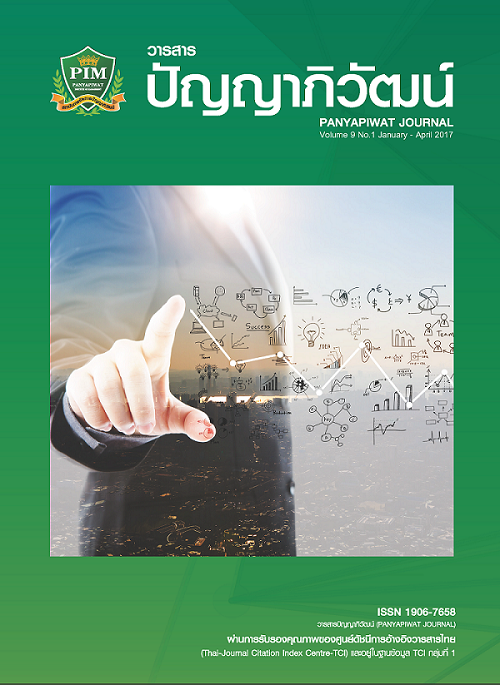การศึกษาการสร้างอัตลักษณ์ของผู้เรียนในสถาบันอุดมศึกษาเอกชน
Main Article Content
บทคัดย่อ
การวิจัยนี้มีวัตถุประสงค์เพื่อศึกษาความคิดเห็นของผู้บริหาร อาจารย์ และนักศึกษาระดับปริญญาตรี ในสถาบันอุดมศึกษาเอกชนเกี่ยวกับการสร้างอัตลักษณ์ของผู้เรียน เป็นการวิจัยแบบผสมผสานวิธีระหว่างการวิจัยเชิงปริมาณและการวิจัยเชิงคุณภาพ กลุ่มตัวอย่างในการวิจัยเชิงปริมาณได้มาด้วยวิธีการเลือกตัวอย่างแบบจัดสรรโควตา ประกอบด้วยอาจารย์และนักศึกษาในระดับปริญญาตรีของสถาบันอุดมศึกษาเอกชน 4 แห่ง ดังนี้ อาจารย์ จำนวน 100 คน และนักศึกษา จำนวน 200 คน เครื่องมือที่ใช้ในการวิจัยคือ แบบสอบถามตรวจสอบคุณภาพของแบบสอบถามโดยนำไปให้ผู้เชี่ยวชาญ จำนวน 3 ท่านพิจารณาและนำไปทดลองใช้กับกลุ่มเป้าหมายที่มีลักษณะใกล้เคียงกับกลุ่มตัวอย่าง วิเคราะห์ข้อมูลโดยหาค่าความถี่ ค่าร้อยละ และวิเคราะห์เนื้อหาแล้วสรุปเป็นค่าความถี่ กลุ่มตัวอย่างในการวิจัยเชิงคุณภาพได้มาด้วยวิธีการเลือกตัวอย่างแบบเจาะจง ประกอบด้วยผู้บริหารของสถาบันอุดมศึกษาเอกชน 4 แห่ง รวม 16 คน เครื่องมือที่ใช้ในการวิจัยคือ แบบสัมภาษณ์เชิงลึกแบบกึ่งมีโครงสร้าง ตรวจสอบคุณภาพของแบบสัมภาษณ์โดยนำไปให้ผู้เชี่ยวชาญ จำนวน 3 ท่านพิจารณาและนำไปทดลองใช้กับกลุ่มเป้าหมายที่มีลักษณะใกล้เคียงกับกลุ่มตัวอย่าง วิเคราะห์ข้อมูลด้วยวิธีการวิเคราะห์เนื้อหา ผลการวิจัยพบว่า 1) ผู้บริหารแสดงความคิดเห็นเกี่ยวกับความหมายของอัตลักษณ์โดยยึดความหมายในประกาศเกณฑ์การประเมินคุณภาพภายนอก รอบสาม (พ.ศ. 2554 - 2558) ส่วนใหญ่กำหนดอัตลักษณ์ของผู้เรียนจากการศึกษาประวัติและวัตถุประสงค์ในการก่อตั้งสถาบัน ด้านวิธีการสร้างอัตลักษณ์พบว่า เน้นการจัดการเรียนการสอนโดยใช้กิจกรรมควบคู่ไปกับวิชาการ และมีความคิดเห็นว่า ผู้เรียนเป็นปัจจัยสำคัญที่สุดในกระบวนการสร้างอัตลักษณ์ 2) อาจารย์ส่วนใหญ่มีความเห็นว่า อัตลักษณ์แสดงถึงความเป็นตัวตนของผู้เรียนซึ่งสอดรับกับปณิธานและวิสัยทัศน์ของสถาบัน ในขณะที่พบว่านักศึกษาส่วนใหญ่ตอบว่าไม่รู้จักคำว่าอัตลักษณ์ ทั้งนี้อาจารย์และนักศึกษาต่างมีความคิดเห็นว่า อาจารย์เป็นปัจจัยสำคัญในการสร้างอัตลักษณ์ของผู้เรียน และอาจารย์ยังมีความคิดเห็นว่า วิธีการสอนที่เอื้อต่อการสร้างอัตลักษณ์ของผู้เรียนคือ การสอดแทรกเนื้อหาที่เกี่ยวข้องกับอัตลักษณ์ของผู้เรียนไว้ในรายวิชา
This research aimed to study the opinions of administrators, lecturers and bachelor degree students in private higher education institutions about student identity construction which was a mix of qualitative and quantitative research. The sample of quantitative research was obtained by quota sampling including lecturers and bachelor degree students from 4 private higher education institutions. They were 100 lecturers and 200 students. The research instruments were questionnaires about the opinions of administrators, lecturers and bachelor degree students in private higher education institutions related to the student’s identity construction verified by 3 specialists and experimented by target groups with similar characteristics to the sample. The data were analyzed by frequency, percentage and content analysis and then summarized in form of frequency. The sample of qualitative research was obtained by specific sampling including administrators from 4 private higher education institutions with the total number of 16 people. The research instruments were semi-structured in-depth interviews verified by 3 specialists and experimented by target groups with similar characteristics to the sample. The data were analyzed by content analysis. The results revealed as follows. 1) The administrators expressed their opinions on the meaning of “identity” by adhering to the meaning stated in the criteria announcement of the third round of external quality assessment (BE: 2554 – 2558 / AD: 2010 - 2015). Mostly, the student identity was determined by studying history and objectives of institutional establishment. According to the identity construction, it was found that learning and teaching management focused on activities together with knowledge. In addition, they agreed that the students were the most important factor in the identity construction process. 2) Most lecturers thought that "identity" presented student identity which was aligned with the institutional missions and visions. However, it showed that most students answered that they did not know the word “identity.” In addition, both the lecturers and the students agreed that the lecturers were the most factors of student identity construction. Moreover, the lecturers thought that the teaching methods contributing the student identity construction was to insert the contents related to the student identity in any course subjects.
Article Details
“ข้าพเจ้าและผู้เขียนร่วม (ถ้ามี) ขอรับรองว่า บทความที่เสนอมานี้ยังไม่เคยได้รับการตีพิมพ์และไม่ได้อยู่ระหว่างกระบวนการพิจารณาลงตีพิมพ์ในวารสารหรือแหล่งเผยแพร่อื่นใด ข้าพเจ้าและผู้เขียนร่วมยอมรับหลักเกณฑ์การพิจารณาต้นฉบับ ทั้งยินยอมให้กองบรรณาธิการมีสิทธิ์พิจารณาและตรวจแก้ต้นฉบับได้ตามที่เห็นสมควร พร้อมนี้ขอมอบลิขสิทธิ์บทความที่ได้รับการตีพิมพ์ให้แก่สถาบันการจัดการปัญญาภิวัฒน์หากมีการฟ้องร้องเรื่องการละเมิดลิขสิทธิ์เกี่ยวกับภาพ กราฟ ข้อความส่วนใดส่วนหนึ่งและ/หรือข้อคิดเห็นที่ปรากฏในบทความข้าพเจ้าและผู้เขียนร่วมยินยอมรับผิดชอบแต่เพียงฝ่ายเดียว”
เอกสารอ้างอิง
Fuengfusakul, A. (2003). Identity: theory and concept frameworks review. Bangkok: National Research Council of Thailand. [in Thai]
Kowtrakul, S. (2001). Educational psychology (5th ed.). Bangkok: Chulalongkorn University Press. [in Thai]
Lairio, M., Puukari, S. & Kouvo, A. (2013). Studying at university as part of student life and identity construction. Scandinavian Journal of Education Research,57(2), 115-131.
McNair, L. D., Newswander, C., Boden, D. & Borrego, M. (2011). Student and faculty interdisciplinary identity in self-management teams. Journal of Engineering Education, 100(2), 374-396.
Ministry of Education Thailand. (2011). Unique and Identity to the third round external assessment.Retrieved December 14, 2011, from http://www.moe.go.th/moe/th/news/detail.php?NewsID=24407&Key=hotnews [in Thai]
Nawsuwan, K. & Singhasame, P. (2014). Thai graduate characteristics toward ASEAN community. Journal of Humanities and Social Sciences Mahasarakham University, 33(5), 212-222. [in Thai]
Niyomrath, R. (2011). Identity of Thai Benjarong Pattern: research. Bangkok: Sunandha Rajabhat University. [in Thai]Nygaard, C. & Serrano, M. B. (2009). Student’s identity construction and learning: reasons for developing a learning-centred curriculum in higher education. Journal of Education Research,3(3), 233-253.
Office of the Royal Society. (2003). The Royal Institute Dictionary BE 1999. Bangkok: Office of Royal Society. [in Thai]
Phannoi, D., Prachanban, P. & Panawong, C. (2014). A causal model influencing identities of Naresuan University Students. Social Sciences Research and Academic Journal, 9(26), 123-138. [in Thai]
Rattanathongkom, S. (2013). Character of student in higher education: handout in 475788 teaching in physical therapy course academic year 2013. Retrieved January 23, 2015, from http://ams.kku.ac.th/aalearn/resource/edoc/tech/54/6learner54.pdf [in Thai]
Ruckchart, S. (2011). A needs analysis of school administrator’s school identity concept and formation. Thesis for the Degree of Master of Education Program in Educational Research Methodology, Department of Educational Research and Psychology, Chulalongkorn University. [in Thai]
Somboon, T. (2008). Identity of “Dek Ram”: research. Bangkok: Research and Development Institute, Ramkhamhaeng University. [in Thai]
Sri-iam, S. (2011). Student identity development in higher education institutions. Thesis Doctor of Philosophy Program in Higher Education, Department of Educational Policy, Management, and Leadership Faculty of Education, Chulalongkorn University. [in Thai]
Suwannachin, C. & Jantarapanya, P. (2015). Students’s identity construction in higher education. Panyapiwat Journal, 7(2), 267-280. [in Thai]
Tontham Publishing. (1994). Terminology. Bangkok: Tontham. [in Thai]


